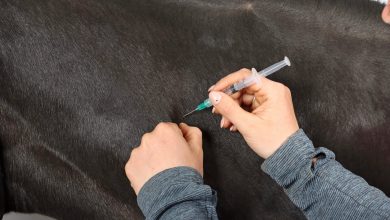Equine Parasite Control

Poop shows up at my equine veterinary clinic in many different ways.Packaged in plastic bags and delivered in the mail, wrapped up in exam gloves in the back of our doctors’ trucks, or carried in by owners in a bucket or a scoop. Sometimes it just appears on our doorstep with a name and a note, “Trigger Jones’ poop.” Usually we know the horse it came from, when he was last dewormed, and what kind of an environment he lives in. But sometimes we don’t. And while we can perform a fecal test on any sample and report results, that information is only meaningful if it’s been collected at the right time and packaged properly.

If you’ve adopted a strategic deworming plan for your horse—that is, one that includes fecal testing—good for you! You’ve been paying attention to the research about emerging resistance to available dewormers. You understand that all dewormers aren’t created equal, horses have varying requirements, and timing makes a difference. Because fecal egg counts provide the evidence you need to make the right deworming decisions for your horse, it’s important to understand what those tests really tell you. And how to make sure you’re getting the right results.
Here, I’ll answer five important questions about fecal testing. With this information, you’ll know when and how to collect a sample, what type of test to ask for, and what to do with the results.
Question #1: When should you test?
Twenty percent of horses will shed 80 percent of the parasite eggs within a herd. Proper administration of an effective deworming medication will result in a negative egg count immediately after deworming in almost every horse. But those high-shedding horses will accumulate more parasites. And typically have higher fecal egg counts sooner after deworming than their more resistant herd-mates. That’s why one of the first goals of a strategic deworming program is to identify these high-shedding horses with poor natural immunity to parasites.
This means that a random sample of poop picked up from the pasture isn’t likely to give you useful information about a specific horse’s level of natural immunity if he was recently dewormed. In fact, along with accurately identifying the sample, timing is one of the most important factors for meaningful fecal sampling. And it varies according to the medication that was used most recently.
To get started with a strategic deworming program, postpone fecal testing until a minimum of 16 weeks after deworming with moxidectin, 12 weeks after deworming with ivermectin, and nine weeks after deworming with either pyrantel or a benzimidazole product. If you’re not sure what product you used, wait at least three months before performing that baseline fecal test.
Regular Sampling
Once that baseline is established, regular fecal sampling can help monitor the success of your program. Horses identified as high shedders should have fecal egg counts performed quarterly. While low-shedding horses can be checked twice each year, immediately prior to deworming. Why check for eggs before deworming instead of after? The goal is to determine whether egg counts are staying below acceptable levels (generally considered to be less than 200 epg, or eggs per gram of feces) between medication administrations. That’s why it’s best to test at the end of your deworming cycle.
The only time when fecal sampling would be recommended soon after deworming is if egg counts are high (greater than 200 epg) at a baseline or end-of-cycle fecal check. Referred to as a fecal egg count reduction test (FECRT), it’s performed on a sample collected 14 days following administration of the medication to check for efficacy. If parasites on your farm have developed resistance, egg counts will remain high even after you’ve dewormed.
You’re Still Doing What?!
A 2015 survey performed by American Horse Publications revealed that 55.3 percent of horse owners still employ a rotational deworming program. Meaning they use a different product to deworm their horses at intervals as frequently as every 6 to 8 weeks.
If you’re a part of that 55 percent, it’s time to decrease frequency of deworming and adopt an evidence-based deworming program that uses fecal testing to help determine which medications are appropriate for treatment. Strategic deworming strategies are not only more effective for keeping your horse healthy, they’re also helping veterinarians and scientists reduce pressure on currently available deworming medications to combat rapidly developing resistance problems.
Bottom line: If we don’t preserve the effectiveness of our deworming medications, we can’t continue to protect our horses.
Question #2: How are you collecting samples?
For best results, fecal material should be collected within 12 hours of being passed. In cold climates, 24 hours may be acceptable. Look for moist samples, as eggs will be preserved better in wet rather than dry conditions. (Not too wet, however! Diarrhea samples won’t give accurate results.) Store each sample in an air-tight container and refrigerate—but don’t freeze—until testing. (Frozen samples won’t yield accurate results.)
An ideal strategy for collecting fecal samples is to pick up a single fecal ball with a gloved hand. Still holding the “apple,” turn the glove inside out as you take it off, creating a “bag” to hold the sample. Squeeze out the air and tie the top of the glove closed with a double knot. Alternatively, use a zippered plastic bag, turned inside-out, to pick up the fecal ball, then pull it around the sample and push out all of the air as you zip it closed. (Yes…it’s true. We need only one fecal ball to test. There’s no need to drop off an entire bucket when you leave your sample on your vet’s doorstep!)
In a perfect world, a fecal egg count should be performed within a week of sampling, although samples may last longer if collected and stored properly.
[READ: MEDS OR MANAGEMENT]Mail-In Testing Services: Use Them Wisely
Do you live in an area where fecal testing is hard to come by? There are several mail-in testing services available that can help you manage your evidence-based deworming program. Most provide a shipping container with instructions and will run a fecal egg count for approximately $20 per sample.
If you use these services, be sure to educate yourself about what results mean. For example, a negative fecal egg count six months after administering a dewormer doesn’t mean “don’t deworm.” Instead, it tells you that your horse is most likely a low-shedder, and that your program’s working.
In addition, find out what test is used, and how accurate these results will be. For example, if you’re simply using a fecal egg count to identify high shedding horses and monitor the efficacy of your program, a McMasters test is probably adequate. But if you have concerns about dewormer resistance, you’d be wise to seek out a more sensitive test, such as the centrifuge-based modified-Wisconsin technique.
Question #3: What type of test are you using?
All fecal tests are not created equal. Qualitative tests that simply tell you whether or not eggs are present aren’t that helpful—especially given that the goal of a strategic deworming program isn’t complete eradication, but rather to keep your horse’s parasite load below an acceptable level. The most useful information comes from a quantitative test with a sensitive detection level that can give you the most accurate estimate of the number of eggs per gram of feces.
The most accurate techniques use a high-speed centrifuge to spin the sample to detect a maximum number of eggs. Called the modified-Wisconsin method, it’s the most common centrifuge-based test used for horses, and has a detection level of 1 egg per gram.
Other techniques, such as the modified-McMasters test, use flotation without centrifugation and won’t give as accurate a number. Typical McMasters tests use two wells (two separate areas of a specially designed slide are counted) to estimate eggs per gram. The detection level of this type of test is 25 eggs per gram. (Note: a three-well McMasters test can provide improved accuracy.)
If you take your fecal samples to your veterinarian, tests may be performed in house or sent to a laboratory for analysis. Don’t be afraid to ask what type of test is used. And if you opt to send fecal samples off in the mail yourself to one of the online testing services available (see “Mail-in Testing Services,” on page 65), consider what type of test is used when making your choice. While either the modified-McMasters or modified-Wisconsin tests are probably sufficient for basic screening, the more sensitive modified-Wisconsin is recommended if you’re performing FECR tests to monitor for resistance problems in your herd.
Tapeworm Test
Tapeworm infections can cause significant health problems for your horse. But a tapeworm diagnosis can’t be made using fecal egg counts. Enter EquiSal, a test developed in the United Kingdom. It can detect a tapeworm burden from a sample of your horse’s saliva with 85-percent accuracy. The test looks for antibodies against tapeworms, and is currently available in the United States from horsemenslab.com. It could soon become an important component of every evidence-based deworming program.
Question #4: What parasites are you testing for?
Historically, large strongyles were considered the “big bad parasites” with the largest impact on your horse’s health. After years of interval deworming based on the lifestyle of the large strongyle, this parasite has been largely eradicated from the horse population. Current focus is on the small strongyle. This is a parasite that causes much less serious disease but has shown remarkable resiliency. And is developing resistance to a number of deworming medications.
Fecal egg counts report the number small strongyle eggs per gram of poop. Roundworm (ascarid) eggs, primarily a health concern for younger horses, shouldn’t be included in the count. Although these eggs will be seen. High roundworm burdens should be reported separately, however, so they can be targeted with your dewormer choice.
Although it’s possible to see tapeworm eggs in fecal samples, they’re uncommon. A fecal test can’t be relied upon to determine whether your horse has a tapeworm infestation. In general, administration of a dewormer effective against tapeworms (either one containing praziquantel or a double dose of pyrantel pamoate) is recommended for all horses, depending on where you live. (See “Tapeworm Test,” above-right, for information about an exciting new saliva-based exam for diagnosing tapeworms.)
Bots
Bots are another type of parasite that won’t be identified on a fecal egg count. In fact, the only time you’ll get definitive information that your horse has bots will be if he ever undergoes an endoscopic examination of his stomach—commonly performed to diagnose stomach ulcers—and bot larvae appear attached to his stomach wall. Of course, if you see patches of little yellow eggs on your horse’s body, these are bot-fly eggs and could indicate that bots might be a problem. In any case, including a bot-effective dewormer (ivermectin or moxidectin) should be a part of your deworming plan for any horse.
Finally, although they haven’t been routinely seen in many years, pinworms seem to be making a comeback. These parasites lay their eggs around your horse’s rectum, but they’ll rarely be seen on fecal egg counts. The sticky-goo that helps them remain attached also causes your horse to itch, leading to tail rubbing. If your horse begins rubbing his tail, your vet can look for pinworm eggs using a Scotch-tape test. (Yes, it’s true: A piece of Scotch tape stuck to your horse’s rectum then pulled away will capture infinitesimal pinworm eggs that can then be identified under a microscope.) If your horse is diagnosed with pinworms, work closely with your vet to determine a treatment plan. These parasites have developed a wide range of resistance issues and can be difficult to eradicate.
Question #5: What should you do with the results?
If your horse is identified as a high or medium shedder, target him for more frequent deworming, three to four times a year. Studies have shown the majority of horses that have high egg counts will consistently have high counts with subsequent tests. However, regular monitoring with quarterly fecal egg counts will allow you to detect when and if your horse ever crosses over into a lower-risk category and can be dewormed less frequently.
Low-shedding horses should still be dewormed twice a year, with fecal tests performed prior to deworming to monitor the success of your program. Until testing for tapeworms becomes more readily available, all horses should be dewormed with a product that’s effective against tapeworms (either one containing praziquantel, or a double dose of pyrantel pamoate) at least once a year.
Although ascarids (roundworms) are rare in mature horses, they’re beginning to make a comeback due to resistance problems. If a large number of ascarid eggs are identified in your horse’s fecal sample, he should be dewormed with a benzimidazole product. This is because many ascarids have developed resistance to ivermectin/moxidectin products.
Finally, if egg counts are high, deworm your horse. And then repeat the fecal test 14 days later to confirm that your deworming medication is effective. Do be aware, however, that a single high egg count within your herd most likely means that your horse is either a high shedder or there was an administration failure. If multiple horses within a herd have high egg counts, you may be battling a resistant population of parasites. That’s when FECR tests are particularly important.
[READ: YOUR HORSE’S HEALTH TEAM]


